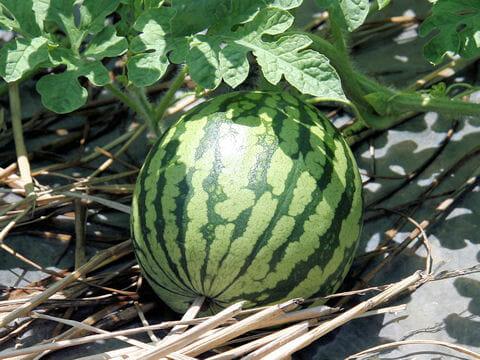History
Melons have been enjoyed for more than 4,000 years. They originated in the hot valleys of southwest Asia, specifically in India and Iran. Early American settlers grew honeydew and casaba melons from seed brought with them from home as early as the 1600s. The first mention of melons in recorded history was found in John Ayto’s Dictionary of Word Origins in 1395. It suggests that the word was derived from the word Melos (the Greek Cyclades Islands, best known for the statue of Venus De Milo). After that entry melons found their way into literature often. The Mahometans – early followers of Mohammed – wrote that eating a melon produces a thousand good works.
Today
A refreshing snack or delightful desert, chilled melons are a sweet and juicy summertime treat. They have been added to salads, salsas, entrees, and drinks. Dried, toasted seeds are also a healthy snack.
Types
All melons come from the gourd family and are related to cucumbers, squash, and pumpkins. The most common melons are:
- Cantaloupe – True cantaloupe. Named for Cantalupo near Rome. Has rough, warty skin, not netted. This European melon is rarely grown in America.
- Casaba Melon – Oval in shape with a pointy end and wrinkled yellowish skin.
- Crenshaw – Or Cranshaw, a casaba crossbreed.
- Honeydew – White to greenish-white rinds with a sweet, refreshing flesh that may be green, white or orange. Similar in texture to cantaloupe.
- Muskmelons – The melon Americans are most familiar with and are called cantaloupe.
 Growing Melons
Growing Melons
Melons thrive in warm weather, 70 to 80 degrees. They prefer slightly acidic soil, 6.0 to 6.5 ph. Melons are voracious when it comes to food and water. Water regularly twice daily, and feed organic fertilizer weekly after they have their third set of true leaves.
Melons, like others of the gourd family, crossbreed easily, so spacing will be important to keep them from cross-pollinating. You should give adequate space between the different melons and between your cucumbers, squashes, and pumpkins too.
In areas where winters are mild, plant your seeds directly in the ground at the same time as you plant your tomatoes– after frost danger has passed and the ground is warm and dry. Make small hills of well-drained, rich soil. Plant three to five seeds two inches apart and one inch deep. Water well and keep the soil moist. When your plants have two sets of true leaves, thin out the smaller/weaker vines, leaving the strongest to grow.
In colder climates – where summer is short – you may want to plant your melons through black plastic to draw warmth into your plants. The plastic will also help conserve water use, control weeds, deter some pests and disease and will make harvesting easier, too.
Lay the plastic over your melon patch in late winter to start warming the soil. Weigh the edges down with rocks to keep it from flying away. Check the soil temperature; when it is above 60 degrees F, you can start planting your melons. Make five-inch X cuts four feet apart. Pull the plastic back and make a hill of soil, with lots of organic matter mixed into it. Plant your seeds as above or transplant the melons that you started indoors.
There are two additional ways to grow melons:
- Heat sink – surround the plants with a medium that will absorb heat during the day and release it into the ground at night. Fireplace brick works well.
- Trellis – construct trellis and reinforce well. It can be made from wire mesh fencing and reinforced with rebar. Make trellis five feet tall. The mesh should be four inches squares, or larger, for ease in harvesting.
In places with short growing seasons, transplanting seedlings will be more successful than seeding directly into the soil. Place potting soil or compost into peat pots two to three weeks before planting time. To strengthen your seedlings, place outside in an area protected from the wind for at least a week before planting in the soil. Pay attention to both air and soil temperature, as melons are very sensitive to cold. When you plant, tear the peat pots down to the top of its soil so that they don’t pull out of the ground. Crack the peat pots and plant in ground level with the soil. Water well. Should cold weather threaten, make mini-greenhouses for your melons from gallon milk jugs. Cut the bottoms off the jugs and cover the plants, pushing the jugs into the soil half an inch deep. When the temperature rises during the day, vent the greenhouses by removing the caps.
Harvest
Melons need heat to ripen well. However, on very hot days they can overripen on the vine, making them looked waterlogged. Melons smell sweet when ripe, so sniff their skin before picking to confirm they are ripe. Another indicator is when the stem separates easily from the melon and the blossom end is soft to the touch. Melons will continue to ripen for two or three days after they have been picked.
Insects and disease
Melons are susceptible to a few pests and diseases; some are more common to one geographic area than another. You are the key to the success of your crop. Walk through the garden several times a week examining the leaves, flowers, vines and fruit. Look for sign of insects or disease. If anything looks suspicious, identify the cause and treat it with the least toxic method possible.
Prevention is key to disease management. Use seed from a reliable source. Give your transplants a good examination before planting. And do your fall cleanup right away; gett rid of diseased plants before adding manure and mulch to the garden for wintering over. Rotate gourds; do not plant them in the same plot again for at least three years.
The most common garden adversaries you will face are:
- Fungus –Alternaria leaf spot, powdery mildew, anthracnose, and downy mildew.
- Insects – cucumber beetles and aphids.
- Mosaic virus
Grow melons in the manner that works best in your garden. Pick, slice, and enjoy. Happy gardening!











